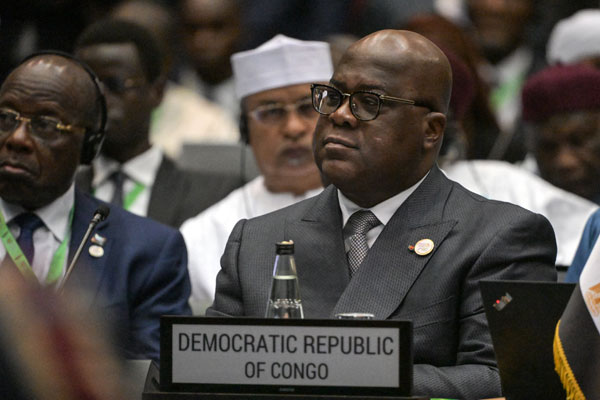Prime
Five things to know about DR Congo

The President of the Democratic Republic of Congo Felix Tshisekedi listens during the 5th mid-year coordination meeting of the African Union, at the United Nations (UN) offices in Gigiri, Nairobi, on July 16, 2023. PHOTO / AFP
What you need to know:
- The second-largest African country in terms of surface area, it is also the fourth most populous state on the continent, with an estimated 100 million inhabitants.
The Democratic Republic of Congo, formerly known as Zaire, is a huge and varied country with a turbulent political history, which is currently ravaged by conflict in its east.
Here are five things to know about this central African nation:
Continent-sized
The DRC spans over 2.34 million square kilometres (904,000 square miles) -- roughly the size of continental western Europe.
The second-largest African country in terms of surface area, it is also the fourth most populous state on the continent, with an estimated 100 million inhabitants.
Some 250 different ethnic groups live in the DRC, speaking hundreds of different languages.
French is the country's official language, and local tongues Kikongo, Lingala, Tshiluba and Swahili are also officially recognised.
Despite its size and diversity -- the former province of Katanga tried to secede in the 1960s -- there is a fierce sense of national unity.
Mineral wealth, dire poverty
The DRC is awash with minerals and precious stones, from gold, diamonds and coltan to tin, copper and cobalt.
Harbouring the Congo River -- the second-largest in Africa after the Nile -- the DRC also has huge hydroelectric potential, as well as 80 million hectares (197 million acres) of arable land.
But decades of war, corruption and chronic mismanagement means that little of the country's enormous wealth trickles down to the population.
About two-thirds of the Congolese population survive on under $2.15 a day, according to the World Bank.
Turbulent politics
The DRC has a history of turbulent politics. Two of its governments have been overthrown violently: in 1965 and then in 1997.
Two of the country's leaders have also been assassinated: Patrice Lumumba in 1961 and Laurent-Desire Kabila in 2001.
Elections are often marked by violence. The vote that brought incumbent President Felix Tshisekedi to power in 2018 marked the first peaceful changeover in Congolese history -- although the results were fiercely disputed.
According to the interior ministry, there are 910 registered political parties in the country.
Conflict
Two major wars devastated the DRC in its recent history. The First Congo War, which lasted between 1996-1997, culminated in the overthrow of former dictator Mobutu Sese Seko.
The Second Congo War, from 1998 to 2003, drew in nine African states and saw the proliferation of dozens of militia groups.
Most of the DRC has returned to relative stability. But its mineral-rich east -- bordering Uganda, Rwanda and Burundi -- remains plagued by armed groups and brutal violence, a legacy of the recent regional wars.
Rumba, survival
Congolese people are renowned for their sense of humour and resourcefulness in the face of trying conditions.
Many jokingly refer to "Article 15" of the constitution, which purports to instruct citizens to sort things out themselves.
Music also plays an outsize role in the country's culture. UNESCO listed Congolese rumba as intangible cultural heritage of humanity in December 2021.
Congo is also famed for its so-called sapeurs -- dandies known for their ultra-elegant clothing and sense of style.





